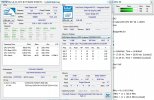Flávio Gomes
Member
Hi!
I'd like to know where I can see the mobo FSB on HWInfo. Please, i need the complete path, ok?
Thank y'all!
I'd like to know where I can see the mobo FSB on HWInfo. Please, i need the complete path, ok?
Thank y'all!
It only shows 99.8 MHz. I wanted to see the full speed, that should be 667 MHz, as you can see below. I have Windows 7 x64.Hi!
When you open HWiNFO choose the Sensors Only mode and it will open a window with all the sensors your system has.
There you will see a sensor next to CPU core speeds named "Bus Clock", or "Base Clock", or "Bus Speed" or something equivalent.
What is your system?
Depending your system this would be 100MHz, or 133MHz, or 200MHz if you havent done any overclocking to it.
On what system?@Zach I'm looking for this!
And according to the linked article QuickPath Interconnect was introduced more than a decade ago. According to Intel Ark, the Celeron 847 launched in 2011, and it doesn't say anything about FSB but generic "Bus Speed" instead.The original front-side bus architecture has been replaced by HyperTransport, Intel QuickPath Interconnect or Direct Media Interface in modern volume CPUs.
Man, i wanna know the MOTHER-BOARD CPU SOCKET BUS SPEED, not the processor bus speed. I wonder why it's so hard for you to understand that. If you don't understand my question, please, don't answer anymore. Thank you all for your help!Your CPU is a mobile Celeron 847 from 2011. Why are looking for speeds based upon a picture from 2005 on completely different system?
Yeah, you helped a lot! I see that the multiplier makes all the difference. What i really wanted to know is the maximum speed of the northbridge alone. I still have to check some information about some details that HWInfo shows, as you can see in the print below, but it seems to me that the FSB of my mobo will be 800 MHz or 1.100 MHz, depending on the circuit you look at, right?Yes, a motherboard can usually run different speeds for the FSB. But that doesn't mean that CPU FSB speed would be any different from the speed at the chipset side (Northbridge to be exact). When you change the FSB speed in a motherboard's BIOS, the CPU and Northbridge run at the same speed. It wouldn't make any sense to drive different speeds on both sides of the bus, because that wouldn't work properly. There is even a performance loss when running the memory at a different speed than the FSB, but that's a whole other story.
Newer CPU's - read, those not from more than a decade ago - have the Northbridge built-in, so there is no separate chip to make a separate bus to. Although technically there's still some kind of bus, but not an FSB, because everything happens right on the CPU substrate (if not the DIE itself).
I hope this makes it more clear.
Regards
Dalai

No, that's the CPU core frequency. LFM means low frequency mode and HFM is high frequency mode. See this Wikichip article for more details.[...] but it seems to me that the FSB of my mobo will be 800 MHz or 1.100 MHz, depending on the circuit you look at, right?
